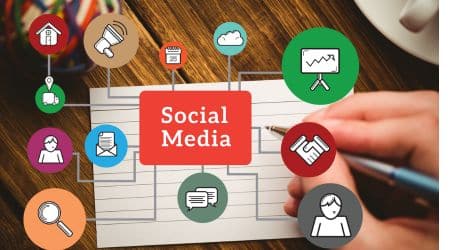Currently, the world is a global village through the use of technology especially the Internet. Social media has greatly influenced the field of public relations since it acts as the bridge through which organizations meet and develop relationships with their audiences. It has grown to be indispensable in practicing public relations and provides numerous channels and outlets to communicate strategy, engage with stakeholders, disseminate messages, and control perceptions and images. This article emphasizes the crucial role and importance of social media in modern public relations practice.
Key Points
- Brands can transform with the help of a strong social media PR strategy and consistent touchpoints, which will amplify your message and provide you the opportunity to speak from a position of strength.
- Social media allows businesses to have friendlier, behind-the-scenes access to information about their goal and brand because it is a more conversational platform. Social media enables a more friendly, personable, and engaging communications strategy as opposed to one that is more official.
- Word-of-mouth marketing is a modern-day version of social media PR. By strategically utilizing hashtags, sponsored posts, and other tools, your brand will establish direct connections with your target audiences on social media as you post, share, and network.
Social Media in Public Relations

Public relations in a wired world are unquestionably redefined.
Traditional methods are still used to improve public communication and image, but what new aspects might social media have brought?
Social media is unquestionably a cardinal element of modern and successful PR, providing communication with timely availability, outreach, and a direct mode of connectivity with audiences.
For PR professionals, all of these advantages come with drawbacks, though. As we examine the complex function of social media in public relations in this piece, it is possible to identify both potential benefits and drawbacks.
Social media has changed the game by expanding the medium and process of organizational messages. This includes Facebook, Twitter, LinkedIn, and Instagram, among others—by allowing two-way communication between the company and the public in real time. The communication channel allows more immediacy and is more personal than traditional media.
#1. Real-Time Communication
Social media in PR have relatively huge benefits, one of them being the ability to communicate in real-time.
That is to say, it ‘installs’, when businesses can pass information together with their pressured concerns and prompt responses to situations that are, for the most part, concerning. The public is primarily informed and engaged by urgency, which eliminates the delay that has been associated with conventional methods of informing the public about important issues through the media.
For example, in a crisis, an organization may quickly spread important information, updates, and remedial measures via social media in good time and manage the situation much better. The ability to respond can help minimize the negative fallout and protect the company’s reputation.
Don’t forget the words of Richard Branson, founder of Virgin Groups, who said and I quote;
“A good PR story is infinitely more effective than a front-page ad. In this, he spoke to time and place of communication, a critical strategic ability greatly magnified by social media, exponentially in this information age.
#2. Wider Base of Reach and Exposure
Social media offers a significant audience ground in which companies can reach out with their products or even stakeholders. This has major effects on managing a brand’s reputation or for true brand awareness.
Furthermore, social media provides a channel for direct communication with the public. In other words, it fosters a sense of community even as it builds brand loyalty.
Engagements, responding to comments, and being more attentive to issues raised, all suggest that businesses get more intimately involved with their target market.
Finally, it helps an organization spread the message to more people.
#3. Less Expense on Communication
Compared to traditional PR techniques like print and television advertising, social media costs are low.
Almost all the tools and platforms are entirely free or, at best, very cheap, hence affordable for all organizations—small and large.
Increased affordability, thus, means that entry costs are minimal, and virtually no organization has an excuse against it. More so, they can put this to good use in creating more value with content development, management of social media platforms, and analytics that boost PR following its broad reach.
#4. Data and Analytics
Analytics tools hold all of the gold in terms of informative data about the behavior of audiences, their preferences, and emerging insights into engagement patterns.
With these facts and figures, PR professionals can further fine-tune the strategies and tactics and create their message in such a way that it would appeal to audiences. Then, with metrics on hand, they can finally measure things like the amount of likes, shares, comments, and click-through rates to see what works and what doesn’t.
#5. Reputation Management:
Social media serves as an instrument for reputation management in the organization. PR specialists can monitor the information posted on Social Media. Likewise, get a chance to address any negative information posted instantly, and ensure that any favorable information that the organization would want the public to know gets out to deal with any reputational threats that may be a factor.
#6. Crisis Communication
Crisis communication is much more manageable when conducted via social media as this allows the organization to directly access and communicate with its viewers.
The post-crisis communication can be also addressed through social media where PR specialists can convey the correct information about the situation to the concerned audience. Therefore, dismissing their worry and demonstrating empathy towards the customers to prevent further damaging effects on the image of the company in the eyes of the consumers.
#7. Customer Service and Support:
An example of a challenging task in the use of social media is in the area of customer service and support, which has been made easy for organizations. It is the job of PR and relevant experts within an organization to foster for actualization of the quick and effective response to different customer concerns, queries, or requests. This, however, improves customer satisfaction and loyalty.
#8. Employee Engagement:
Organizations can effectively manage and guide all of their members through the use of social media, which will contribute to the growth of the idea of partnerships.
In such a manner, employees of different departments will nurture a positive attitude toward the company and its activities. PR professionals will utilize opportunities to enhance the positive morale among employees by announcing key company events, rewarding valuable employees, and engaging them in PR-related projects.
The importance of social media in employee engagement cannot be emphasized. This is because it fosters a vibrant and connected workplace environment, creating a sense of togetherness and community spirit that is fundamental to any organization’s success and growth.
Disadvantages of Social Media in Public Relations
A snag to this, however, is that with all these benefits of social media, it also has some rather specific challenges and disadvantages for public relations professionals. For instance, the ultra-rapid spread of misinformation, allowance for unpleasant reactions that occur at all times in case a negative PR campaign erupts, and the demand to churn out everyday content while monitoring.
#1. Spreading of False Information
Among the vast drawbacks of social media is the fact that, on a speedy scale, it may be able to aid the spread of misinformation.
This can create much confusion and, finally, destroy a brand’s image quickly. This is because false information can pass through different media from one platform to another with the speed of fire. PR should, therefore, have to monitor any inaccurate or harmful information on all social media platforms and react immediately to put out any wrong perspective that might be brewing.
Such agility is vital in a contemporary world where an issue such as Starbucks’ racial discrimination case in 2018 can go viral on social media the moment an issue takes place, thereby causing a PR crisis. The company had to act fast, damage control, correct information, and make changes very swiftly so that the sentiment was changed to win back the public.
As WARREN BUFFETT, CEO OF BERKSHIRE HATHAWAY, eloquently said, “IT TAKES 20 YEARS TO BUILD A REPUTATION AND FIVE MINUTES TO RUIN IT.”
That’s how much important it is in today’s digital world to be constantly vigilant and to act briskly.
#2. Negative Feedback on Reputation Management
Social networks offer a venue for everyone to voice their opinions, but they also carry risks for businesses. Sometimes a harsh customer review or a reported complaint from the company might become well-established and rapidly gather traction, culminating in a public relations crisis. The proper management of negative comments and criticism requires that there be a good strategy in answering concerns—minimizing the aggravation of the situation.
For example, in 2017, one of the passengers was physically dragged off by United Airlines from an oversold flight. The recorded video incident was spread over social media like wildfire. An overwhelming and negative public perception challenge went the way of the company, positing from issuing several public apologies to changing company policies to remedy the situation.
This demonstrates the need for proactive reputation management and the necessity of having adequate plans in place for handling negative feedback and handling crises.
Importance of Social Media in Public Relations
The role of social media in public relations is vast and cannot be underscored strongly enough, notwithstanding the shortages.
It plays a significant part in creating and later managing a company’s high reputation, allowing direct, all-around, and uninterrupted communication with audience members to research useful insights—invaluable in decision-making.
Let’s look at some of these roles.
#1. Building and Maintaining Reputation

Well-built or maintained reputations can be achieved through social media.
Displaying visible transparency and regular sharing of valid information in the media adds positively to the face value of the organization, hence, a good reputation as faithful and credible.
Furthermore, it also provides the companies with an outlet to react to issues and crises immediately.
Through practical and transparent management of such problems, companies can generally reduce these impacts on the reputation of a front company—proactive reputation management in the digital, high-speed age.
#2. Direct Communication
Social media engages companies directly with their audiences—the response and feedback are immediate. Through this, one can create and maintain positive relationships with customers and stakeholders in a social context. When a company contributes valuable information on such social platforms as social media, it shows responsibility toward customer satisfaction and community involvement in answering questions and initiating a conversation.
For instance, companies can use Twitter to respond to customer inquiries in real-time, addressing concerns and building trust.
As noted by Gary Vaynerchuk, CEO of VaynerMedia,
“THE CUSTOMER SERVICE YOU PROVIDE THROUGH SOCIAL MEDIA IS THE FRONT LINE OF YOUR BUSINESS.”
This immediate interaction is invaluable in maintaining a positive public image and ensuring customer satisfaction.
#3. Providing Valuable Insights
Social media analytics provide much information to guide most Public Relations strategies and decisions. These inform companies about audience preferences and behavior through the study of audience demographics, patterns in engagement, and prevailing sentiment. Information like that helps PR professionals fine-tune messages while targeting campaigns more effectively and measuring the initiative’s success.
For example, brands can use social media analytics to create the materials that are more engaging to audiences and, consequently, become conscious of the best time to post them and on which platform one will get the most traffic. This can give insights into fine-tuning strategies that may significantly improve PR efforts.
#4. Reach and Amplification:
Social media platforms are commonly used. They can reach a large number of people, making the PR specialist’s priorities easier in terms of reaching out to all stakeholders.
PR Social Media Strategies
As a result, strategic planning is an essential component of social media public relations activities, allowing businesses to align their objectives, map out their approach, and maximize the potential of digital platforms to achieve their goals.
Developing content, expanding engagements, establishing connections with influencers, and managing virtual crises are important strategic initiatives.
#1. Content Creation and Curation
The dissemination of quality material that is sufficiently relevant to make a message is still vital to a business’s success on social media PR.
A program should make its content speak to the targeted market: imaginative, exciting, informative, and instructive. To keep the audience engaged, motivated, and active, the content should be given in a variety of formats, including blogs, videos, infographics, and interactive elements.
In addition to producing fresh content, the company is positioned as a thought leader in that field through the curation of content from recognized sources.
Sharing value-added content from other sources shows commitment to adding value and keeping up with happenings and trends in the industry.
#2. Interaction
Social media PR, on the other hand, involves engagement with the audiences. To establish a committed connection, businesses must actively engage and respond to comments, issues, and requests.
Such engagement builds trust and loyalty as the audiences feel that companies are listening to them and are likely to care about their worries. Another level of interactiveness that can give originality to content includes adding things like polls, Q&A, or a live stream. This is very important because interaction with the audience can help a company gather feedback, answer questions, and have good relations with the audience.
#3. Influencer Partnerships

Working with influencers will help spread a company’s voice to more people. Influencers are used to give somebody a lot of credibility because they already have a solid and devoted following.
For example, when a beauty brand partners with a popular beauty influencer on Instagram, the influencer’s endorsement can significantly boost the brand’s visibility and credibility among their followers.
As Jeff Bezos, founder of Amazon, stated,
“YOUR BRAND IS WHAT OTHER PEOPLE SAY ABOUT YOU WHEN YOU’RE NOT IN THE ROOM.”
Influencers can shape these conversations positively, enhancing the organization’s reputation.
#4. Crisis Management
Implementing a crisis management plan is necessary to address the increase in social media concerns. Another necessary quality is a company’s agility. That is, it must be ready to react promptly and suitably to any unfavorable comments, adverse information, or possible public relations crisis. Regular social media monitoring systems for potential problems, an appropriate communication plan, and openness in handling difficulties are required.
💡PRO TIP: A strong PR strategy anticipates any risks to your reputation. Unfavorable things can always occur. It makes sense to be ready to handle certain circumstances, and that's precisely what a public relations strategy can assist with. It is crucial to plan ahead for such a situation and develop persuasive words and communications to counter it.
A well-drawn-up crisis management plan could help to reduce the downsides of such occurrences and diminish impacts on a company’s reputation. Timely and transparent responses on the part of a company could be proof of accountability and concern for customer satisfaction.
How Do Social Media Platforms Use Public Relations?
Using social media as a public relations tool makes it easier to attract customers, mold their opinions, launch fresh branded entertainment and advertising campaigns, handle customer relations, use influencer marketing, and have two-way conversations with customers. This is critical because it helps brands build the required trust with their customers. This allows them to not only increase the frequency of their advertising across more channels, thereby establishing brand awareness in the market but also to have brand loyal customers.
What Is the Purpose of Online Media in the Public Relations Industry?
The goal of online media in public relations practices is to disseminate news and information. Furthermore, it serves as proof of a company’s reputation and equally serves as a branding tool, identity, and image.
Moreover, it uses technology for advertising and customer targeting and monitors customer feedback to involve and enlist the support of customers in a campaign that can generate popularity and sales.
What Is a Major Advantage of Using Social Media for PR Activities?
One of the major advantages of using social media in PR activities is that it gives a far-reaching and diversified audience reach, both practical and timely.
A PR professional can connect with customers, opinion leaders, and the general public on a more personal level – that is, interactively – for enhanced engagement and brand recognition. Beyond this, social media also provides a platform for instant feedback and real-time interaction that will help shape public opinion and build customer loyalty.
How Can a PR Person Build a Relationship With the Media?
A PR person’s strong rapport with the media should be built on trust and mutual respect— an understanding initiated by acknowledging the needs of the press. Providing timely and relevant information calls for proactivity. Valuable story ideas should flow without reluctance, and media inquiries ought to be promptly addressed. Such a relationship hinges on regular engagement with journalists: respecting their deadlines, and being open and honest in communication.
Conclusion: Embracing the Power of Social Media
To summarize, social media is more than just a tool… The public relations sector must fill a huge PR-shaped vacancy. These are unique opportunities for direct connection, brand building, and reputation management. Despite the numerous impediments, the opportunity for positive change is vast. Brands must use social media wisely and engage in genuine interactions with their target audience to reach even the most distant audiences with the best interest.
Thank you for reading the contents of this article!
With social media, you can make your PR campaign more relatable and develop relationships.
Related Articles
- 7+ Jaw-Dropping Public Relations Rates Secrets You Need to Know Before Hiring
- The Role of Public Relations in Tourism and Travel: Practical Tips and Personal Stories
- How to Write the Perfect Press Release: My Tips on Formatting
- How to Protect Your Brand Online & Offline (Expert Tips)
- 10 Social Responsibility Examples That Will Restore Your Faith in Humanity






